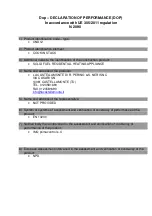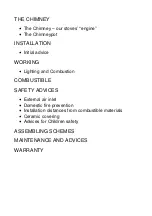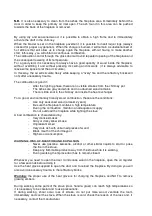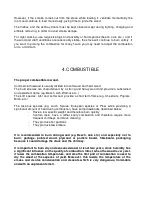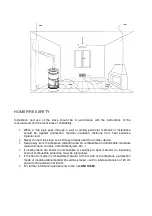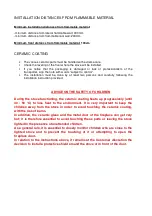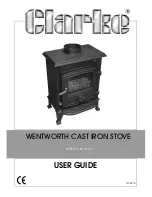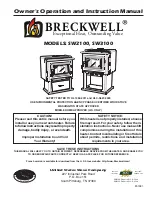
However, if the smoke comes out from the stove while loading it, ventilate momentarily the
room and continue to load more slowly, giving time to ignite the wood.
The firebox and the ashtray doors must be kept closed except during lighting, charging and
embers removing, in order to avoid smoke escape.
For night working, use large size logs and possibly of hard species (beech, oak, etc..) and if
the wind and draft conditions are reasonably stable, the stove will continue to burn calmly. If
you want to prolong the combustion for many hours, you may need to adjust the combustion
air to a minimum.
4.COMBUSTIBLE
The proper combustible is wood.
Commercial firewood is usually divided into soft wood and hard wood.
The hard species are characterized by a strong and heavy wood and provide a substained
and persistent flame (eg. Beech, Ash, Walnut, etc..)
The soft species, light and soft wood, provide a short term flame (eg. Chestnuts, Poplars,
Birch, etc.)
The resinous species (eg. Larch, Spruce, European species of Pine) while providing a
significant amount of heat during combustion, have some drawbacks described below:
-
Have a low specific weight and therefore burn quickly
-
Contain resin, have a rather sooty combustion and therefore require more
frequent chimneys and stove cleaning
-
They produce hot particles
-
They produce few embers
It is recommended to burn strong wood (eg. Beech, oak, etc.) and especially not to
burn: garbage, painted wood, plywood or particle board, fibreboard, packaging
because it could damage the stove and the chimney.
It is important to burn dry and seasoned wood, at least two years, since humidity has
a significant influence on the quality of combustion. Infact, when the wood is very wet,
it lower the combustion temperature, and also the first part of combustion is used to
dry the wood at the expense of yield. Moreover, this lowers the temperature of the
smoke and creates condensation and creosote which is very dangerous, flammable
and with an unpleasant smell.
Summary of Contents for COOKIN STACK
Page 6: ...FIG 2 A FIG 2 B FIG 2 C ...
Page 8: ...FIG 2 E ...


